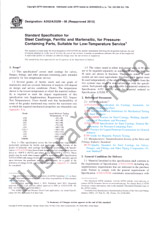Potřebujeme váš souhlas k využití jednotlivých dat, aby se vám mimo jiné mohly ukazovat informace týkající se vašich zájmů. Souhlas udělíte kliknutím na tlačítko „OK“.
ASTM D8462-22
Standard Test Method for Cyclic Plate Load Tests to Evaluate the Structural Performance of Roadway Test Sections with Geosynthetics
Přeložit název
NORMA vydána dne 1.7.2022
Informace o normě:
Označení normy: ASTM D8462-22
Datum vydání normy: 1.7.2022
Kód zboží: NS-1067000
Počet stran: 6
Přibližná hmotnost: 18 g (0.04 liber)
Země: Americká technická norma
Kategorie: Technické normy ASTM
Anotace textu normy ASTM D8462-22 :
Keywords:
cyclic plate loading, geosynthetics, pavement testing, performance, rut, stationary traffic benefit ratio (S-TBR), traffic benefit ratio (TBR),
Doplňující informace
| Significance and Use |
|
5.1?The CPL test is intended as a performance test to quantify the benefits of geosynthetics in pavement structures, as recommended by AASHTO R 50-09. Performance is predominantly defined in terms of S-TBR. 5.2?The CPL test is a laboratory test used to accelerate rutting in a roadway cross section using a stationary cyclic plate. While the application of load differs from actual roads, the results from similarly constructed CPL tests are useful to evaluate and compare the performance of various products or designs. The results from these tests are most relevant to roads having similar design characteristics (material strengths and thicknesses). Note 1:?The extrapolation of cyclic plate results to designs
that deviate significantly from the parameters tested may not be
accurate, and performance calculations made at significantly
different load cycle levels than the expected service life of an
actual pavement may not provide an accurate estimate of the
benefits actually realized.
5.3?The number of load cycles applied by the CPL device corresponds to the number of equivalent single-axle loads (ESALs) used in the AASHTO 1993 pavement design equation. 5.4?The test method is applicable to geosynthetics and soils used in typical pavement applications. 5.5?This test method produces test data that can be used to compare geosynthetic products, construction methods, and cross section configurations used in design of roads. 5.6?This test can be used to characterize specific behaviors of the geosynthetic under the conditions tested by including sensors to measure stresses and strains within the pavement cross section or on the geosynthetic itself. Sensors should be appropriately sized and installed to minimize their influence on the results of the test. 5.7?The relationship between load cycles and deformation is a function of the composite stiffness of the constructed system and the interdependence between the individual components of the design. |
| 1. Scope |
|
1.1?This standard test method outlines the procedure used to determine the performance of unpaved and paved roadway cross sections, with and without geosynthetics, that are built in a controlled manner and tested using a stationary, cyclic load applied to the surface to simulate traffic. 1.2?Test section performance from these tests is normally calculated as a function of life extension, but can also be determined based on structural improvement. Life extension is related to the number of load cycles that can be accommodated by a particular configuration when compared to a similarly constructed control. Structural improvements are based on elemental or system-wide stiffness increases. 1.3?The cyclic plate load (CPL) test is intended to be a performance test conducted as closely as possible to as-built unpaved and paved roadway cross sections. It has been used as a tool to compare different geosynthetics; soil types, strengths, and thicknesses; and construction procedures for a variety of pavement applications. 1.4?UnitsThe values stated in SI units are to be regarded as standard. Values in parentheses are for information only. 1.5?This standard does not purport to address all of the safety concerns, if any, associated with its use. It is the responsibility of the user of this standard to establish appropriate safety, health, and environmental practices and determine the applicability of regulatory limitations prior to use. 1.6?This international standard was developed in accordance with internationally recognized principles on standardization established in the Decision on Principles for the Development of International Standards, Guides and Recommendations issued by the World Trade Organization Technical Barriers to Trade (TBT) Committee. |
Doporučujeme:
Aktualizace technických norem
Chcete mít jistotu, že používáte pouze platné technické normy?
Nabízíme Vám řešení, které Vám zajistí měsíční přehled o aktuálnosti norem, které používáte.
Chcete vědět více informací? Podívejte se na tuto stránku.




 Cookies
Cookies
